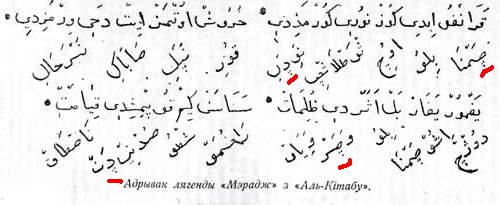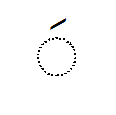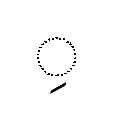Belarusian Arabic alphabet
The Belarusian Arabic alphabet (Belarusian: Беларускі арабскі алфавіт, Biełaruski arabski ałfavit (Latin script)) or Arabitsa (Арабіца), was based on the Arabic script and was developed in the 16th century (possibly 15th). It consisted of twenty-eight graphemes, including several additions to represent Belarusian phonemes not found in the Arabic language.
The Belarusian Arabic alphabet was used by the Lipka Tatars, who had been invited to settle in Belarusian territory, at the time part of the Grand Duchy of Lithuania. During the 14th–16th centuries they gradually stopped using their own language and started using the Old Belarusian language rendered in the Belarusian Arabic alphabet. Books of that literary tradition are known in Belarusian as Kitab (Belarusian: "Кітаб"), which is Arabic for book.
Some Polish texts were also written in the Arabic script in the 17th century or later.[1]
Additional graphemes
- For the sounds /ʒ/ (ж), /tʃ/ (ч) and /p/ (п), which are absent from the Arabic language, the following Persian graphemes were used:
- پ چ ژ
- For denoting the soft /dz/ (дз) and /ts/ (ц) sounds, the following newly constructed graphemes were used:
- These graphemes were used during the 16th–20th centuries to write Belarusian and Polish.[1]
- The sounds /w/ (ў) and /v/ (в) were both represented by the same symbol:
- و
Equivalence chart
Vowels
-
Vowels A and E (initial اَ)
-
Vowels I and Y (initial اِ)
-
Vowels U and O (initial اُ)
-
No vowel
-
Сonsonant doubling
Consonants
Ligature
| Cyrillic | Latin | Arabic | |||
|---|---|---|---|---|---|
| Contextual forms | Isolated | ||||
| Final | Medial | Initial | |||
| Ла ла, Ля ля | Ła ła, La la | ـلا | لا | ||
See also
- Belarusian Latin alphabet
- Arebica – modified Arabic script used for the Bosnian language
References
Further reading
- Akiner, Shirin. Religious Language of a Belarusian Tatar Kitab: A Cultural Monument of Islam in Europe. Otto Harrassowitz, 2009.
- Д-р Я. Станкевіч. Беларускія мусульмане і беларуская літаратура арабскім пісьмом. [Адбітка з гадавіка Беларускага Навуковага Таварыства, кн. I.] – Вільня : Друкарня Я. Левіна, 1933 ; Менск : Беларускае коопэрацыйна-выдавецкае таварыства ″Адраджэньне″, 1991 [факсімільн.]. – 3-е выд.
- Антон Антановіч, "Беларускія тэксты, пісаныя арабскім пісьмом"
External links
 Media related to Belarusian Arabic alphabet at Wikimedia Commons
Media related to Belarusian Arabic alphabet at Wikimedia Commons- Kitabs, the unique highlight of the Belarusian language at pravapis.org






